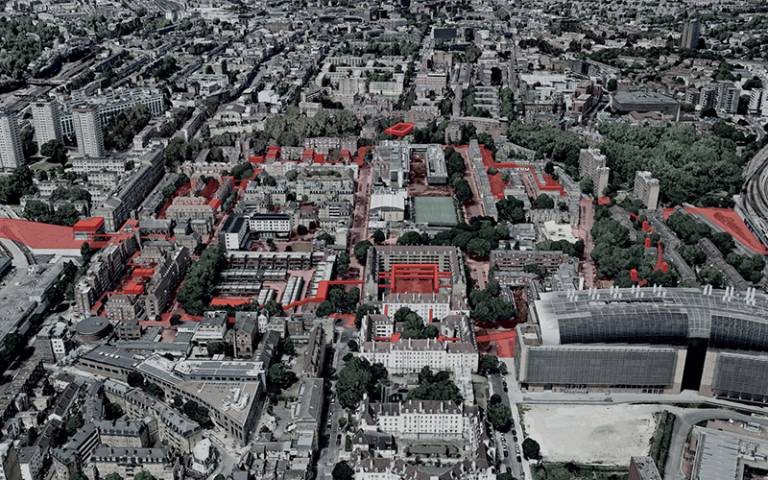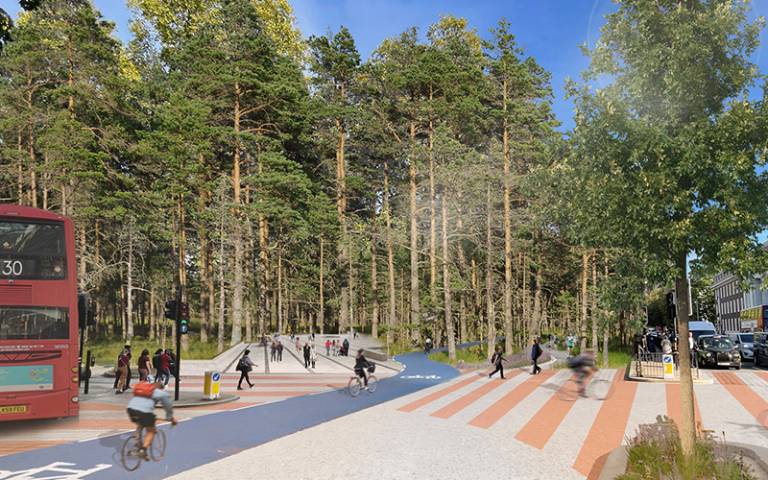New and Sustainable Designs for Euston Road Presented by The Bartlett and Leading Practices
21 November 2023
Design concepts from Fletcher Priest Architects, White Arkitekter, AHMM and Arup, alongside selected students from The Bartlett School of Architecture, will be presented at The London Centre this month.

In an innovative partnership between architectural practice and teaching, The Bartlett School of Architecture is publishing a new report, Euston Road: Propositions for Change, exploring alternative uses for the Euston Road corridor. The report combines the visionary research of leading London practices and graduate students from the school, to design a better, greener and more sustainable urban space.
With the support of British Land, Camden Council, and Living Streets, the new report collates design propositions from four London-based architecture practices – Fletcher Priest, White Arkitekter, AHMM and Arup – in parallel with a selection of conceptual projects from Bartlett graduate students.
Euston Road, a key access point to London from Euston Station as well as a major highway across the city, has been in a constant state of flux and change since its inception in 1756. Originally, the road marked the northern boundary of London, separating the Great Estates to the south from the disadvantaged neighbourhoods that were being built to the north. Today, Euston Road carries around 1,730 vehicle movements an hour during peak time and forms part of the northern boundary of the Congestion Charge zone.

Euston Road: Propositions for Change suggests a range of alternatives to the current state of Euston Road, considering the changing nature of living, working and travel for the future of London. Importantly, the plans are also scalable, and can form the inspiration for how to develop major transport routes within cities across the UK. Propositions from the four architecture practices include innovative ways of knitting together the busy street, improving pedestrian and transport experience, and boosting the urban greening factor of the area.
A key driver behind these proposed designs for Euston include the necessity to plan for climate change, with increased biodiversity and a focus on sustainable construction and travel built into the plans. This includes the planned development of Euston Station to accommodate the delivery of HS2, as well as the recent expansion of the Ultra Low Emissions Zone and likely future rules to encourage sustainable transport including the promotion of cycling, and light electric vehicles including scooters.
Peter Bishop, Professor in Urban Design at The Bartlett School of Architecture, said:
Students and practitioners were asked to come up with a series of design propositions. These are not set proposals - rather they are challenges to what might be possible in places like Euston Road. We should aspire to use architecture in a creative way and I hope that this report will trigger a healthy debate about what Euston Road might become in the future.
Euston Road: Propositions for Change will launch at The London Centre on 28th November 2023, with the architecture practices and organisations behind the report presenting the designs and discussing the local and national impact the proposals could have on the future of urban development.
Images
Top: Somers Town Park by Eylül Bulgun, Junbin Ge, Thomais Kordonouri and Iason Ntounis (Architecture & Historic Urban Environments MA)
Below: Euston Road Forest, proposal by Fletcher Priest Architects
 Close
Close

